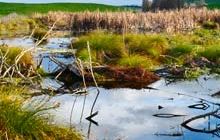Rescued matuku-hūrepo released back to productive wetlands
Archived content: This media release was accurate on the date of publication.
Introduction
A rare matuku-hūrepo/Australasian bittern was released following a successful rehabilitation at Auckland Zoo.Date: 22 June 2023
A rare matuku-hūrepo/Australasian bittern was released into its wetland habitat at Lake Rotokawau, on the Poutō Peninsula of the Kaipara Harbour last Friday, following a successful rehabilitation at Auckland Zoo.
Te Ākitai Waiohua, Te Uri o Hau, DOC, and Auckland Zoo worked together to transport and release the juvenile female.
The bird was found severely emaciated and dehydrated in a residential backyard in Pukekohe, South Auckland. Under the Zoo vet team’s careful care, it gained weight from just 468 grams to a healthy weight of over 950 grams.
Te Ākitai Waiohua, one of the iwi from the area of where the bird was found, gifted the name Te Awanui relating to a body of water in Pukekohe.
Nick Turoa from the Tūpuna Maunga Authority farewelled Te Awanui with a karakia on behalf of Te Ākitai Waiohua, who handed over the role of kaitiaki of the bird to Te Uri o Hau in Northern Kaipara.
Colin French, Pou Kaitiaki of Te Uri o Hau, says “They were abundant on the entire Poutō Penisula back in the day until development wiped out their habitat, wetlands and lakes.
“We are honoured to be a part of the rehabilitation of the matuku-hūrepo. The area it was released into was part of a replanting program with DOC, NRC and the local community, marae and Poutō School.”
Rotokawau is situated between a system of lakes, most of which have predator control systems put in place. With plenty of food, and a vast amount of natural resources, alongside a good population of other matuku-hūrepo, Te Uri o Hau believe this particular bird should have no problems settling in.
DOC staff attached a tracker to the bird to help to learn more about the movements and behaviours of this cryptic species.
“Matuku-hūrepo appear to travel through a greater wetland that is shared between Waikato, Auckland and Northland. Food availability and accessibility has become a growing issue for them,” says Harry Caley, Wetlands Bird Science Advisor, DOC.
“If a young bird, like this individual, starts its independent life with limited foraging success, it then struggles to find better places to find food as flying to search for new areas is expensive energy wise. It is a cascade of unfortunate events.
“We’re very hopeful that with its new-gained strength and with the support of the rich surrounds, this young female will become a successful parent in the years ahead,” says Harry.
Sadly a second matuku-hūrepo that was found within days of the first bird died on Friday.
Karen Wilson of Te Ākitai Waiohua say that the iwi recognise the significance between these birds, matuku-hūrepo, and the two maunga in Tāmaki Makaurau, Matukutūreia and Matukutūruru, known together as Ngā Matukurua.
“The birds were found close to these maunga. One of these maunga is known as ‘standing and watchful’ (Matukutūreia) and the other maunga ‘restful’ (Matukutūruru) – mimicking these two birds,” says Ms Wilson.
Auckland Zoo veterinarian Dr Adam Naylor says after six weeks of intensive care at the Zoo’s vet hospital it was incredibly rewarding to see Te Awanui released back to the wild.
“Matuku-hūrepo are an extremely cryptic, secretive, and sensitive species that typically don’t do well in human care, but a significant factor in Te Awanui’s favour was that she self-fed from day one.
“To give her the best possible chance, we created a quiet, calm environment for her and offered her live invertebrates along with dead mice, chicks, and fish – all foods that she would naturally hunt in the wild,” says Dr Naylor.
Found throughout New Zealand and parts of Australia, today there are fewer than 1000 of these ‘Nationally Critical’ birds left in Aotearoa. Habitat loss is a major driver as 90% of wetlands’ habitat has been lost, primarily due to being drained for urbanisation and agriculture.
Supporting and caring for wetlands, both freshwater or estuarine (coastal), can help matuku-hūrepo.
The public can get involved through planting and restoration, careful recreation around these areas such as limiting boats and 4WDs, predator control, and keeping pets under control.
The public can also get involved in listening surveys for matuku-hūrepo. Report all sightings or booming calls of matuku-hūrepo to the nearest DOC office.
Australasian bittern/matuku-hūrepo territorial call (MP3, 1,886K)
02:00 – Booming call.
Contact
For media enquiries contact:
Email: media@doc.govt.nz


